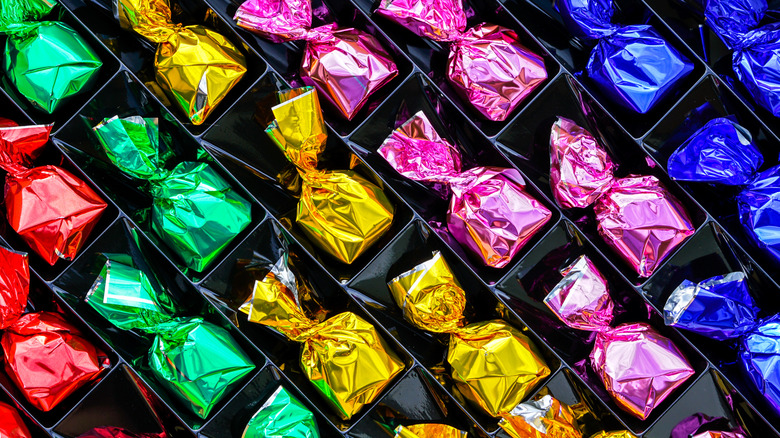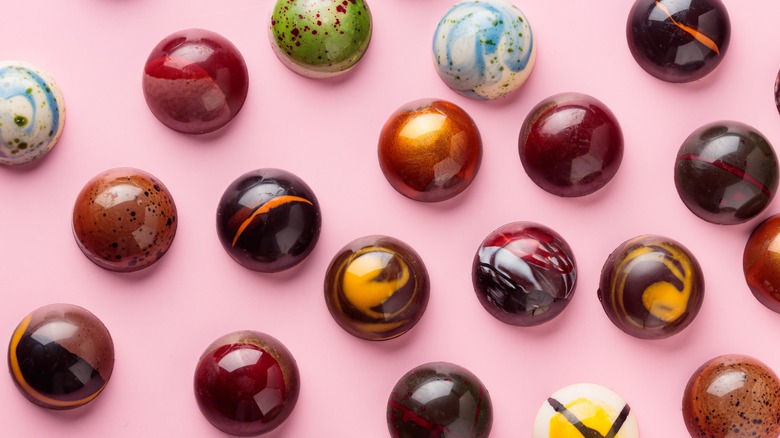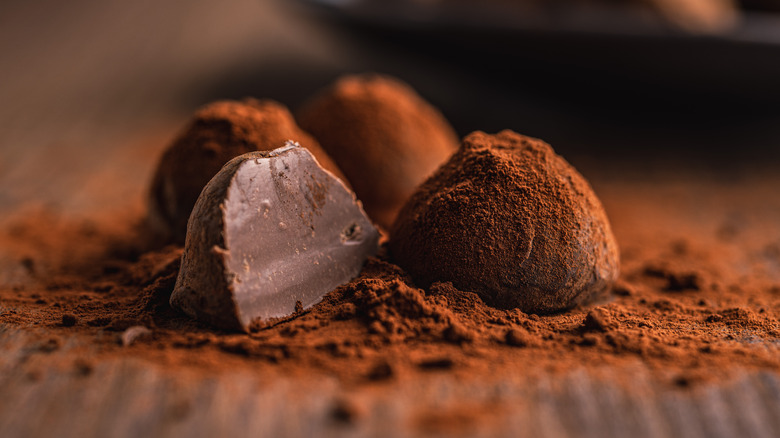What Separates A Bonbon From A Truffle
Chocolate is without a doubt one of the world's greatest (and most irresistible!) commodities. The U.S has a particularly vested interest in this sugary treat: According to Gitnux, it accounts for 20% of the world's total chocolate consumption and as such, consumes the most of any country globally. One of the reasons why chocolate is so popular — in addition to its obvious deliciousness — is its incredible versatility.
Whether you choose to eat it straight from the block, utilize it as part of a chocolate mousse recipe, or drink it as iced or hot chocolate, there are certainly plenty of mouthwatering options to pick from. One particularly scrumptious way to enjoy chocolate is in the form of a bonbon or truffle. Synonymous with special occasions, these pint-sized delights are often confused for one another but the truth is, they're actually quite different. Bonbons are molded chocolates typically containing fillings like caramel, fruit puree, or liqueur, whereas truffles have a chocolate filling that is rolled in ingredients like cocoa powder, chopped nuts, or coconut.
How to spot a bonbon in the wild
Bonbons are the treat so good they were named twice. Their moniker comes from the French word bon (meaning good), and is actually a blanket term for any small sweet found in France. Generally speaking, however, bonbon refers to bite-sized confections covered in chocolate. The bonbon's prestigious reputation probably comes from the fact that they were once enjoyed by French royalty and exchanged as gifts amongst the wealthy; packaged in pretty containers furnished with brightly colored tissue paper (the original chocolate boxes, if you will).
Today's bonbons can vary in looks and flavor, but share the same basic makeup — a thin shell of tempered chocolate (chocolate that has been melted then reset to create a stable, shiny product with an audible snap when bitten or cracked) surrounding a soft center, sealed with additional tempered chocolate to keep the filling fresh. Many bonbons make use of caramel, while plain or flavored chocolate ganache, fruit curd, nougat, praline, and nut-based creams are also popular options.
The bonbon's most defining feature is its glossy outer shell, which over the years has been decorated in ways that the original French chocolatiers could only imagine. As well as being crafted in practically every color under the sun — edible gold leaf, paint-like splatters, and a marbled watercolor effect are just some of the other embellishments modern bonbon makers have embraced (and a rather fitting nod to their opulent heritage).
Chocolate truffle traits
Chocolate truffles are not to be confused with the white and black fungal variety, despite the fact that they were named because of their resemblance to the latter when covered in cocoa powder. One popular theory as to their creation is that they were invented by mistake, when famed French chef Auguste Escoffier accidentally poured hot cream, intended for another dish, onto chocolate. He quickly realized that the resulting mixture could be rolled into balls, and thus the truffle was born.
Similarly, today's truffles center around a small ball of ganache (melted chocolate mixed with cream and sometimes butter) that can be infused with essences, liqueurs, and other ingredients to change up the flavor before being cooled and rolled into the token round truffle shape. The finished product is then dusted with cocoa powder or something texturally complex like nuts, chopped fruit, chocolate sprinkles, and freeze-dried fruit powder. Some truffles are even dipped in tempered chocolate, which is, of course, also used for the outer shell of bonbons (and may, in fact, explain some of the confusion surrounding these two treats). All of this to say that while bonbons and truffles may not be created equal, they are equally delicious.


